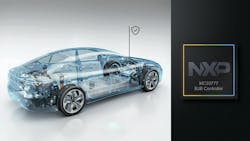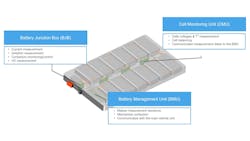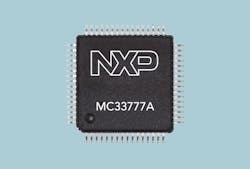NXP’s Novel Battery Junction Box IC Enhances EV Pack Monitoring
The high-voltage lithium-ion (Li-ion) battery packs in electric vehicles have high energy density and are long-lasting. But they also tend to be fragile. Mechanical stress or damage caused by a crash can puncture the battery pack or impair the cells inside it. Overcharging or even undercharging the battery can lead to premature charge termination, reduce its operating lifespan, or even cause catastrophic failures that could trigger thermal runaway.
With everything that can go wrong, these batteries must be carefully managed to ensure every Li-ion cell operates within the voltage, current, and temperature levels that define its safe operating area (SOA). To do so, they must also be constantly and closely monitored not only at the cell level, but at the pack level, too.
NXP recently rolled out a battery junction box IC that combines critical pack-level monitoring functions in a single chip. According to the company, it delivers faster, safer, and more flexible battery management for the high-voltage packs in EVs.
The new chip, the MC33777, can measure the currents, voltages, and temperatures in the battery pack and, importantly, measure them redundantly to meet the ASIL D standard for automotive safety. NXP said it also features onboard diagnostics so that it can detect and then react to short circuits and other fault conditions. In that way, it can help prevent safety hazards or power surges from damaging the system.
The MC33777 can also function as an electronic fuse, giving automakers the ability to remove the single-use fuses traditionally used to disconnect the high-voltage battery pack from the EV during a system fault.
“Integrating everything that’s required to monitor a battery pack and react quickly to safety-critical events into a single device delivers significant benefits,” said Jesus Ruiz Sevillano, NXP’s director of BMS product marketing.
Specifically, NXP said it can reduce the component count by up to 80% by integrating more of the monitoring and protection functions for battery packs. That not only contributes to space savings, but it reduces software development effort as well.
The Battery Junction Box: Safety Monitor for the BMS
Battery management is becoming a make-or-break feature given the rising complexity of EV battery packs.
Modern EVs are loaded with huge battery packs constructed of long strings of Li-ion cells connected in series that can achieve operating voltages of 400 to 800 V—or higher. According to NXP, the latest EV battery packs typically comprise more than 200 individual cells. These bulky energy storage systems can weigh up to thousands of pounds and cost thousands of dollars, accounting for as much as 30% to 40% of the average EV’s cost.
>>Check out these TechXchanges for similar articles and videos
In turn, the battery-management system (BMS) is playing more of a pivotal role in today’s EVs. The BMS is used to monitor the voltage of every battery cell as well as the voltage, current, and temperature of the larger battery pack over its lifetime It also carefully manages all of these parameters to make sure it’s operating reliably, safely, and with optimal performance. Besides wringing out as much power as possible out of the EV battery per charge, it prevents catastrophic damage that can occur in the event of a short circuit or other fault.
At the heart of the BMS is a high-performance microcontroller (MCU) that calculates the state of charge (SOC) and the state of health (SOH) of the battery pack and adjusts charging and discharging to maximize both metrics.
To make sure that the battery pack performs at its best, the BMS must monitor the situation inside the battery cells very accurately. NXP also introduced a battery-cell controller IC, the MC33774, that can closely supervise the voltage in each battery cell. From inside the cell monitoring unit (CMU) in the BMS, it can accurately measure the voltage of the battery cells to within 0.8 mV. Furthermore, NXP said it can monitor up to 18 cells at a time, and the chips can be daisy-chained together to measure even more battery cells.
One of the risks associated with high-voltage EV batteries is thermal runaway. If any of the battery cells are overcharged, undercharged, or physically damaged, they can overheat uncontrollably, causing a chain reaction that can spread to other cells in the pack, potentially causing them to ignite or explode. Internal short circuits within cells will also trigger thermal runaway in EV batteries. EV battery fires burn extremely hot, and they’re harder to extinguish because they’re initiated by chemical reactions.
The battery junction box consists of contactors, fuses, pre-charge circuit, and current sensors, along with the other components to connect the EV’s high-voltage battery pack to the traction inverter, onboard charger (OBC), and other loads when necessary—and disconnect it when in danger. Located inside or on top of the battery pack, it’s monitors monitor conditions inside the EV battery to prevent short circuits or other hazards, guaranteeing safety and reliability.
Sometimes called a battery disconnect unit (BDU), the battery junction box also monitors the insulation resistance between the high- and low-voltage domains of the BMS to catch defects in the battery pack and protect against hazardous conditions.
The battery junction box IC can measure voltages and currents at the pack level instead of the cell level and communicate the data to the MCU. By monitoring the EV battery pack directly instead of relying on the MCU, the MC33777 can more accurately monitor the voltage and current of the pack with lower noise, said NXP. The IC features an isolated daisy chain or serial peripheral interface (SPI) bus to communicate with the MCU, which considers the cell voltage, pack voltage, and pack current to estimate SOC and SOH.
NXP’s battery-management IC can monitor the voltage of the battery pack through resistors placed on the high-voltage bus, while it can check out the current of the battery pack using shunt-based or Hall-effect current sensors.
Fast and Accurate Sensing Safeguards Against EV Fires
One of the main responsibilities of the battery junction box is the detection and prevention of short circuits or other surges of current that can lead to catastrophic failure of the battery or even cause it to erupt in flames.
NXP’s new chip keeps high-voltage battery packs from harm by constantly monitoring the current and slope, sampling the battery pack every 8 µs for evidence of transient currents (di/dt) or other issues. It can also detect a wide range of configurable events up to 10X faster than other battery-management ICs that only identify issues when the battery pack runs over specific current, voltage, or temperature limits, said NXP. The configurable logic in the chip can react to these fault conditions without engaging the MCU.
The MC33777 features four current measurement channels, and they can be paired up and run redundantly to meet the ASIL D standard for functional safety in cars. Each channel contains separate high-precision and high-speed analog-to-digital converters (ADCs). The high-precision channel measures signals at up to 1 kHz with 24 bits, while the other channel delivers 16 bits of resolution with up to 125 kHz of signal bandwidth. For monitoring voltage and other aspects of the battery, NXP said the chip features 16 additional analog inputs.
One of the more distinctive features is its “fuse emulation” technology. In most cases, a BMS uses traditional, single-use fuses to physically disconnect the high-voltage battery pack from the EV’s loads and the vehicle’s chassis in the event of a short circuit or other fault condition. These fuses melt when too much current travels through them, interrupting the flow of current. But these fuses can be expensive and unreliable, stated NXP.
According to the company, its pack monitoring IC can mimic a traditional fuse. When the current inside the battery pack climbs to dangerous levels, the IC uses its internal logic to independently control two high-voltage separators, also called “pyro-fuses.” These switches use a small explosive force to instantaneously disconnect the EV battery pack from loads, preventing electrical overloads that can cause their highly combustible cells to erupt into flames.
By disconnecting the battery pack from the rest of the system quickly and reliably, NXP said the IC can also reduce the risk of electric shock in the event of a collision. If one of the switches malfunctions, the other one can cover for it.
A modern BMS is also used to correct for temperature fluctuations inside the EV battery cells and the larger pack. Exposure to severe heat and cold can lead to large variances in the battery’s overall performance and lifespan, so the BMS must be able to adapt to the varying conditions under the hood of the EV. The new chip can keep track of the thermal situation at the pack level by measuring the temperature of the shunt resistors.
However, the MC33777 is not all about safety and reliability, said NXP. The BMS can leverage its more accurate pack-level voltage and current measurements to maximize the battery’s useful capacity and boost the EV’s driving range.
>>Check out these TechXchanges for similar articles and videos
About the Author
James Morra
Senior Editor
James Morra is the senior editor for Electronic Design, covering the semiconductor industry and new technology trends, with a focus on power electronics and power management. He also reports on the business behind electrical engineering, including the electronics supply chain. He joined Electronic Design in 2015 and is based in Chicago, Illinois.





